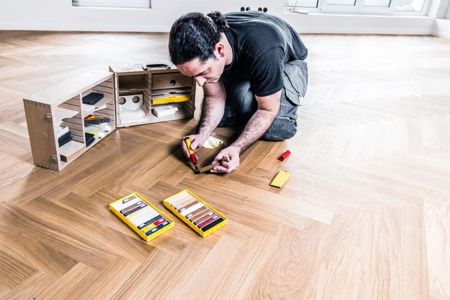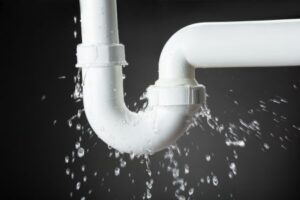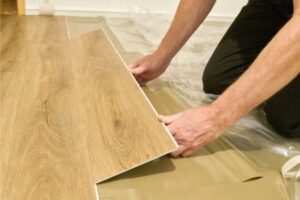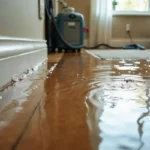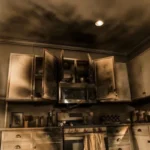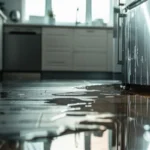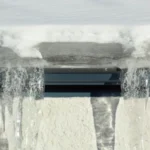Vinyl flooring is a popular choice for its durability and water resistance, but it is not entirely waterproof. Excess moisture from leaks, spills, or flooding can seep beneath the surface, leading to warping, mold growth, and even subfloor damage. If left untreated, these issues can worsen over time, compromising the integrity of your flooring and requiring costly repairs. Acting quickly is essential to minimize damage and restore your vinyl floor to its original condition.
This guide will walk you through each step of the restoration process, from assessing the severity of the damage to deciding whether repairs will suffice or a complete replacement is necessary. You will also learn how water restoration services can help expedite drying, prevent mold, and ensure long-term flooring protection. You can restore your vinyl flooring, safeguard your subfloor, and extend its lifespan with the right approach.
How does water infiltrate vinyl flooring?
While some vinyl flooring boasts waterproof claims, it is crucial to understand that they often refer to surface spills, not prolonged exposure or seepage from below. Standing water and long-term exposure to water intrusion can damage even water-guarded flooring. Water can find its way under vinyl flooring through various avenues:
Leaking appliances
Washing machines, dishwashers, and refrigerators are common culprits of hidden leaks. Even a slow drip can lead to moisture buildup beneath vinyl flooring, weakening adhesives and creating the perfect conditions for mold growth. Water restoration can help detect hidden moisture and dry affected areas before further damage occurs.
Plumbing issues
Cracked pipes, faulty connections, or even condensation can lead to water seeping under your vinyl planks. If left unaddressed, this moisture infiltration can compromise the integrity of the flooring, causing warping, swelling, or mold growth. Even small and sporadic leaks and plumbing issues can cause major issues for water-damaged flooring.
Flooding
Heavy rain, basement floods, or burst pipes can saturate the subfloor beneath your vinyl and leave standing water there to soak into the floor materials. Once moisture is trapped, it can cause planks to lift, buckle, or warp. Water restoration amenities can efficiently remove excess water, dry the area, and restore your flooring before permanent damage occurs.
Improper installation
Gaps around the perimeter or an insufficient moisture barrier can serve as entry points for water, potentially causing damage to your flooring. These openings allow moisture to seep beneath the surface, leading to issues like warping, buckling, or mold growth. Properly sealing gaps and installing an effective moisture barrier are essential.
DIY Steps for Restoring Water-Damaged Vinyl Floors
Water damage can weaken vinyl flooring, leading to warping, discoloration, and mold growth. Acting quickly prevents further issues and saves the cost of a complete replacement. Below are the key steps to effectively restore water-damaged vinyl floors.
Identify the Damage
Check for bubbling, warping, or discoloration. Press down to detect moisture trapped underneath. If only a small section is affected, a simple repair may work. However, extensive damage may require replacement. Water restoration services can help assess and address hidden moisture issues before they escalate.
Dry the Area
Before making repairs, remove all moisture to prevent mold growth. Use towels to soak up excess water, then set up fans and dehumidifiers to speed up the drying process. Open windows and doors to improve air circulation if the damage is severe. Lifting the affected section can help expose stubborn moisture trapped under vinyl planks to airflow. Ensuring the area is completely dry prevents future flooring issues and improves repair longevity.
Remove Damaged Sections
If parts of the vinyl flooring are severely damaged, peeling, or warped, they must be removed. Use a utility knife to cut around the affected area carefully. For planks, gently lift and detach the damaged pieces without disturbing the surrounding flooring. If the flooring is glued down, loosen it with a heat gun or adhesive remover. Be cautious not to damage the subfloor beneath; keeping it intact will make the replacement process much smoother.
Dry and Disinfect the Subfloor
Once the vinyl is removed, check for moisture or mold on the subfloor. Use fans and dehumidifiers to dry it thoroughly. Wipe the area with a disinfectant or a water-vinegar solution to eliminate bacteria and mold spores. If mold is present, water repair services can provide deep cleaning solutions to prevent further spread.
Replace Vinyl Flooring
With the area prepped, install new vinyl flooring to match the existing surface. For vinyl planks, snap them into place securely, ensuring proper alignment. If using adhesive-backed vinyl, apply the new adhesive evenly and press the flooring down firmly. Make sure the replacement fits seamlessly with surrounding sections. If necessary, trim the edges for a precise fit. Take your time to ensure the new vinyl adheres properly and blends in with the existing flooring.
Seal and Protect
To prevent future water damage, apply a waterproof sealant over seams and edges. This creates a protective barrier, reducing the risk of moisture seeping underneath. Consider using vinyl with waterproof backing for high-moisture areas like kitchens or bathrooms. Regular maintenance, such as promptly wiping spills and avoiding excessive water exposure, helps extend the lifespan of your vinyl flooring. For added protection and indoor humidity control, explore these tips on dehumidifying wood floors, which are also applicable to maintaining vinyl in moisture-prone areas.
When to Replace vs. Repair Vinyl Flooring
Deciding whether to repair or replace vinyl flooring depends on the extent and severity of the damage. Minor issues, such as surface scratches, small tears, or isolated water damage, can typically be repaired without needing a complete replacement. Patching kits work well for minor cuts or gouges, and swapping them out is a practical, cost-effective solution if only a few planks or tiles are affected. Adhesive-backed vinyl and floating floors allow for seamless repairs when damage is contained to a small section. Addressing these issues early prevents them from worsening and helps maintain the integrity of the surrounding flooring.
However, replacement may be the best option when damage is widespread, more severe, or recurring. Warped planks, significant discoloration, or vinyl that is peeling away often indicate underlying moisture issues. If water has seeped beneath the flooring, mold growth or subfloor deterioration may occur, making simple repairs ineffective. In these cases, removing and replacing the damaged flooring ensures long-term stability and prevents further structural problems. If the subfloor has become soft, warped, or mold-infested, attempting to repair only the top layer will not resolve the issue.
Persistent water damage or mold growth can pose health risks and weaken the flooring over time. If moisture problems continue despite repairs, professional water restoration services can assess the extent of the damage and recommend the most effective course of action. Experts use specialized tools to detect hidden moisture and determine if replacement is necessary. While repairs are ideal for minor damages, replacing the flooring ensures a durable, moisture-resistant solution.
If you are uncertain whether to repair or replace, consulting water restoration facilities will help you make the best decision for the longevity and safety of your flooring.
Prevention is Key: Protecting Your Vinyl Flooring from Water
Proactive measures can go a long way in preventing water damage under your vinyl flooring:
- Regular maintenance: Inspect your appliances and plumbing for leaks or potential issues and fix minor issues as soon as possible.
- Moisture barrier: Ensure a proper moisture barrier is installed beneath the vinyl flooring during installation to guard against water damage.
- Appliance placement: Avoid placing water-intensive appliances such as ice makers and water dispensers directly on vinyl flooring.
- Spill response: Act promptly to clean up spills and prevent water from seeping under the planks and soaking in deeper.
- Proper ventilation: Maintain good ventilation in bathrooms, kitchens, and laundry rooms to prevent condensation and moisture buildup.
- Professional Inspections: Water restoration services can detect hidden moisture and prevent long-term damage before it worsens.
Understanding the causes, signs, and solutions to water damage under vinyl flooring allows you to safeguard your floors and maintain a healthy, comfortable living environment. Remember, early detection and prompt action are key to minimizing the impact of water woes and keeping your vinyl flooring looking its best for years to come.
Don’t Gamble with Moisture! Trust the Vinyl Water Damage Repair Specialists!
Are you dealing with water damage under your vinyl flooring? Our expert team specializes in water restoration services, providing professional solutions to restore your floors efficiently. We use advanced moisture detection tools, industry-approved drying techniques, and high-quality restoration methods to protect your home.
Our trained technicians assess the severity of the damage and create a tailored restoration plan. Whether it is drying, mold prevention, or vinyl replacement, we ensure the job is done right. Contact us today for reliable water restoration services and restore your flooring to its original condition!
How to Restore Your Water-Damaged Vinyl Floor FAQs
1. Can vinyl flooring be saved after water damage?
2. How do I know if water is trapped under my vinyl flooring?
3. Will mold grow under water-damaged vinyl flooring?
4. Can I repair vinyl flooring myself or should I hire a professional?
5. How can I prevent future water damage to my vinyl flooring?

